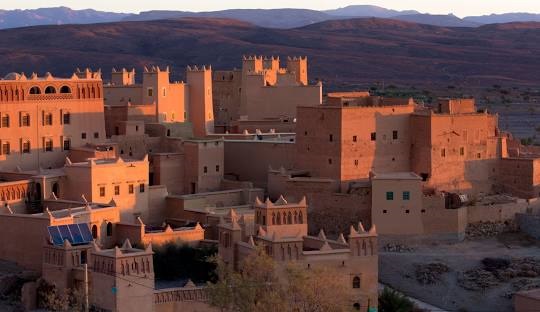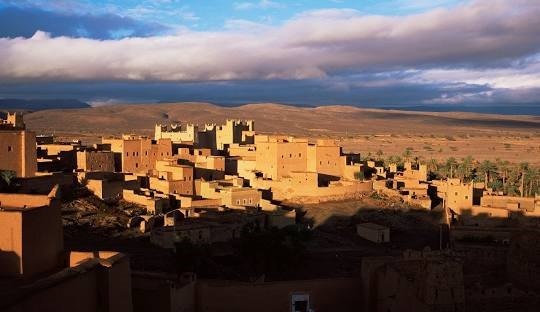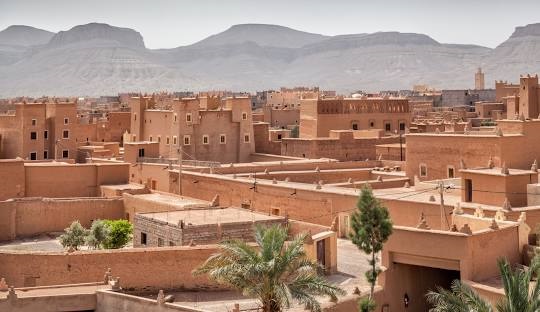The Atlas Mountains, home to Riad Nkob, is a sweeping range that extends across North Africa. A geographical marvel of towering peaks, deep valleys, and diverse landscapes. Stretching approximately 2,500 kilometers through Morocco, Algeria, and Tunisia, this mountain range serves as a significant geographical, cultural, and ecological divider between the Mediterranean coastline and the vast Sahara.
Atlas Mountains
The Atlas Mountains are not just a physical barrier, but also a region rich in history, culture, and biodiversity. They are divided into several distinct ranges, each with its unique characteristics and geological history. The three main sections are the Middle Atlas, High Atlas, and Anti-Atlas. The first one, located in northern Morocco, is characterized by its rolling hills and high plateaus, often covered in cedar and oak forests.
The High Atlas, also in Morocco, is the most dramatic part of the range, featuring the highest peak in North Africa, Jebel Toubkal, which stands at 4,167 meters. The Anti-Atlas lies to the south of the High Atlas and is known for its arid landscapes and unique rock formations. Geologically, the Atlas Mountains are a complex region formed by the collision of the African and Eurasian tectonic plates.
This collision began around 80 million years ago and continues to shape the mountains today, resulting in a landscape that is a testament to the dynamic forces of Earth’s crust. The range’s geology is varied, with limestone, sandstone, and volcanic rock layers reflecting its tumultuous geological history. The presence of these diverse rock types has led to the formation of a variety of landforms, including deep gorges, steep cliffs, and rugged peaks.
The climate of the Atlas Mountains varies significantly from one region to another due to its vast expanse and varying altitudes. The northern slopes, closer to the Mediterranean, receive more rainfall and have a more temperate climate. In contrast, the southern slopes, descending towards the Sahara, experience a much drier and harsher climate.
This variation in climate has resulted in a rich tapestry of ecosystems, ranging from lush forests and alpine meadows in the higher, wetter areas to arid shrublands and desert environments in the lower, drier regions. The Atlas Mountains are home to a wide range of flora and fauna, many of which are endemic to the region.
The higher elevations, particularly in the High Atlas, are home to species such as the Barbary macaque, a primate native to North Africa, and the Atlas cedar, a tree species that is emblematic of the region’s forests. Other notable species include the Cuvier’s gazelle, the Barbary sheep, and the endangered Barbary leopard, which is rarely seen but remains a symbol of the region’s natural heritage.
The diversity of plant life is equally impressive, with over 1,000 plant species, many of which are unique to the region. Atlas Mountains have been a cradle of human civilization for thousands of years. The Berber people, who are indigenous to North Africa, have lived in the Atlas Mountains for millennia, developing a rich cultural heritage that is intricately linked to the landscape.
The Berbers, or Imazighen as they call themselves, have adapted to the challenging mountain environment through a combination of agriculture, pastoralism, and trade. Terraced farming is a common sight in the valleys, where crops like barley, wheat, and olives are grown, while nomadic and semi-nomadic herders move their livestock between highland pastures in the summer and lower valleys in the winter.
The Atlas Mountains have also been a crossroads of cultures and civilizations throughout history. Carthaginians, Romans, Arabs, and later European colonial powers have all left their mark on the region. The mountains served as a natural fortress for the Berbers against invading forces, allowing them to maintain a degree of independence and preserve their cultural identity.
This history of resistance is still evident today in the strong sense of community and cultural pride among the Berber people. The Atlas Mountains are dotted with small villages and towns, where traditional Berber culture is still very much alive. These communities are known for their distinctive adobe architecture, vibrant markets, and colorful festivals.
The Berber language, Tamazight, is widely spoken in these areas, and efforts to preserve and promote the culture and language have gained momentum in recent years. Traditional crafts, such as carpet weaving, pottery, and silver jewelry making, are important aspects of Berber culture and continue to thrive in the Atlas Mountains.
In recent decades, the Atlas Mountains have become a popular destination for tourists seeking adventure, culture, and natural beauty. The High Atlas, with its dramatic peaks and valleys, attracts hikers, mountaineers, and trekkers from around the world. The ascent of Jebel Toubkal is particularly popular, offering a challenging but rewarding climb with breathtaking views of the surrounding mountains and valleys.
Other popular trekking routes include the Aït Bouguemez Valley, know for its lush landscapes and traditional Berber villages, and the Mgoun massif, which provides a more remote and less crowded experience. In addition to trekking and mountaineering, the Atlas Mountains offer a range of other outdoor activities.
Rock climbing is popular in areas like the Todra Gorge, where steep limestone cliffs provide challenging routes for climbers of all levels. Mountain biking and skiing are also growing in popularity, with several ski resorts operating in the High Atlas during the winter months. The Oukaïmeden Ski Resort, located near Marrakech, is the highest ski resort in Africa and attracts both local and international visitors.
Cultural tourism is another important aspect of the Atlas Mountains’ appeal. Many visitors come to experience the unique Berber culture, staying in traditional guesthouses, and participating in local customs and traditions. Tours often include visits to historic kasbahs, ancient fortified villages that dot the landscape, and local markets, where visitors can purchase traditional crafts and sample regional cuisine.
The Atlas Mountains’ proximity to major Moroccan cities like Marrakech and Fes makes them an accessible destination for tourists looking to explore both urban and rural Morocco. Despite their natural beauty and cultural richness, the Atlas Mountains face several challenges. Climate change is having a noticeable impact on the region, with decreasing rainfall and rising temperatures affecting both natural ecosystems and human communities.
Traditional farming practices are becoming increasingly difficult to sustain, leading to changes in land use and migration from rural to urban areas. Deforestation and overgrazing have also contributed to soil erosion and habitat loss, threatening the region’s biodiversity. Conservation efforts are underway to address these challenges and protect the Atlas Mountains’ unique natural and cultural heritage.
Several national parks and protected areas have been established to preserve critical habitats and promote sustainable tourism. The Toubkal National Park, Morocco’s oldest national park, is a prime example of these efforts, focusing on protecting the High Atlas’ unique flora and fauna while supporting local communities through eco-tourism initiatives.
Local and international organizations are also working to promote sustainable development in the region, supporting projects that improve water management, reforestation, and sustainable agriculture. Education and awareness campaigns are helping to promote the value of the region’s natural and cultural resources, encouraging both locals and visitors to participate in conservation efforts.
The Atlas Mountains are a region of immense natural beauty, cultural richness, and historical significance. From their rugged peaks and deep valleys to their vibrant communities and diverse ecosystems, the Atlas Mountains offer a glimpse into the heart of North Africa. As a vital part of the region’s geography and culture, they continue to shape the lives of those who call them home and captivate the imaginations of those who visit.



